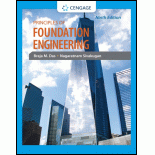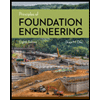
Concept explainers
Repeat Problem 11.1 based on LRFD using the following factors:
load factor for dead load = 1.25
load factor for live load = 1.75
strength reduction factor on the ultimate bearing capacity = 0.50
11.1 A continuous foundation is required in a soil where
Want to see the full answer?
Check out a sample textbook solution
Chapter 11 Solutions
Principles of Foundation Engineering
- Repeat Problem 11.1 based on LRFD using the following factors: load factor for dead load = 1.25 load factor for live load = 1.75 strength reduction factor on the ultimate bearing capacity = 0.50 11.1 A continuous foundation is required in a soil where d = 10 kN/m², = 26°, and y = 19.0 kN/m³. The depth of the footing will be 1.0 m. The dead load and the live load are 600 kN/m and 400 kN/m, respectively. Determine the required width for the foundation based on allowable stress design with FS = 3, using Eq. (6.10) and Table 6.1.arrow_forward(a) Design a Shallow Foundation to support a dead load of 500 kN/m and an imposed load of 300 kN/m in a silty sand. Characteristic values of shear strength parameters are c|= 10 kN/m2 and ø| = 40°. The saturated unit weight of the soil is 20 kN/m3 and the unit weight above the water table is 17 kN/m3 . (a) determine the required size, shape and depth of the footing if a lumped factor of safety of 3.0 against shear failure is specified and assuming that the water table (i) is well below the foundation level (ii) may rise to foundation level (iii) may rise to the surface (b) determine if a foundation of that size, shape and depth would satisfy the bearing resistance limit state?arrow_forwardThe square footing shown below must be designed to carry a 2400 KN load. Use Terzaghi's bearing capacity formula and factor of safety = 3. Determine the foundation dimension B in the following two cases: 1. The water table is at Im below the foundation (as shown). 2. The water table rises to the ground surface. 2400 kN O = 32° C = 50 kN/m? Yd = 17.25 kN/m³ 2 m 3m B Ys = 19.5 kN/m³arrow_forward
- The square footing shown below must be designed to carry a 2400 KN load. Use Terzaghi's bearing capacity formula and factor of safety = 3. Determine the foundation dimension B in the following case : a. If the water table is at foundation level 2400 kN $ = 32° C = 50 kN/m² Ya = 17.25 kN/m³ 2m 3m Y, = 19.5 kN/m³arrow_forwardIt is planned to construct a rectangular foundation with base dimensions of 8 * 14 m (B* L) on the construction site with the ground profile as in the figure. Accordingly, if the YASS descends 9 m, what would be the change in the final bearing capacity of the ground? Note: Make your calculation using the Terzaghi bearing capacity formula as the safety factor of 3 0m c=18 kPa, -18° Y=20 kN/m³ Y-21,8 kN/m³ 1.5 m SM H e=0.67 2.7 m GW 12 m c=8 kPa, -23° e=0.23 Yo=22 kN/m³ Y-23,2 kN/m³arrow_forwardA 300 mm x 400 mm column is to be supported by 530 m thick square footing @ its center. Service DL = 597 kN, service LL = 676 kN, CC to bar centroid is 90 mm, fc' = 24.7 MPa and fy = 414 MPa. Consider the weight of the footing and soil to be 16.04% of the dead load. SBC = 160 kPa %3D 300 400 300 Determine the required number of 20 mm bars parallel to the critical side. Note: Present the width (B) in multiples of 100 mm.arrow_forward
- A 30 x 24 ft mat foundation is to be placed at 9 ft depth in a saturated clay where Cu= 1200 Ib/ft² and - 0. Find the net ultimate bearing capacity.arrow_forwardA continuous foundation is required in a soil where c' = 10 kN/m², o' = 26°, and y = 19.0 kN/m³. The depth of the footing will be 1.0 m. The dead load and the live load are 600 kN/m and 400 kN/m, respectively. Determine the required width for the foundation based on allowable stress design with FS = 3, using Eq. (6.10) and Table 6.1. %3D thearrow_forwardA square foundation is placed at a depth of 1.5 m within a sandy clay where c'=14k/m2 , phi'=23 and y=18 kN/m3 to carry a column load of 950 kN. Determine the width of the foundation that can be allowed on the foundation with a factor of safety of 3 and use the width value you have found to calculate the allowable bearing capacity(assume general shear failure and use gross values for the Terzaghi Bearing Capacity formulation for the given foundation type). If you don't write down the required equation to find the width of the foundation you cannot get credit from this question. Use the table given to you in the figure.arrow_forward
- A strip footing foundation 1 m wide is constructed in the slope of a hill whose surface inclination is 20°. The soil in the hill is a dense sand, with a unit weight of 19 kN/m3 and an angle of internal friction of 40°. Assume that the D/B ratio is about 1. Applying a factor of safety of 3, determine the wall loading the foundation can carry, per meter of footing length.arrow_forward2. A medium dense sand is proposed to support a square foundation having a width and length of 5 feet as shown below. The bottom of the footing is 2.5 feet below the ground surface. The water table is 4 feet below the bottom of the footing. Using a factor of safety of 3, what is the allowable bearing capacity of the proposed footing? Gs= 2.6 e = 0.5 Ø = 35° 5 ft d = 4 ftarrow_forwardA footing 2.50 m x 2.50 m is located at a depth of 1.5 m in sand. The shear strength parameters to be used in design are c' = 0 and o' = 38°. What is the net ultimate bearing capacity of footing if the water table is at 3 m below foundation level? The unit weight of sand is 18 kN/m3 and FOS = 3 For O' = 38°, N, = 67 and Ng = 49arrow_forward
 Fundamentals of Geotechnical Engineering (MindTap...Civil EngineeringISBN:9781305635180Author:Braja M. Das, Nagaratnam SivakuganPublisher:Cengage Learning
Fundamentals of Geotechnical Engineering (MindTap...Civil EngineeringISBN:9781305635180Author:Braja M. Das, Nagaratnam SivakuganPublisher:Cengage Learning Principles of Foundation Engineering (MindTap Cou...Civil EngineeringISBN:9781337705028Author:Braja M. Das, Nagaratnam SivakuganPublisher:Cengage Learning
Principles of Foundation Engineering (MindTap Cou...Civil EngineeringISBN:9781337705028Author:Braja M. Das, Nagaratnam SivakuganPublisher:Cengage Learning Principles of Foundation Engineering (MindTap Cou...Civil EngineeringISBN:9781305081550Author:Braja M. DasPublisher:Cengage Learning
Principles of Foundation Engineering (MindTap Cou...Civil EngineeringISBN:9781305081550Author:Braja M. DasPublisher:Cengage Learning


